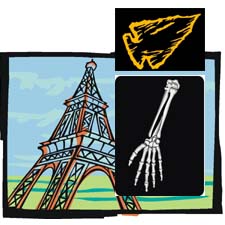|
FRESH STUFF DAILY |
|
|
||
|
|
||
|
|
||
|
SEE ALL SIGNED BOOKS by J. Dennis Robinson click here |
||
Passaconaway has been called the greatest leader of New England natives. Were his remains discovered in 1820 and shipped to France? What happened when NH asked for them back in 1984? Are they still there?
History News Update But the attempt "fizzled" according to current NH State Archaeologist Richard Boisvert contacted this week on the 20th anniversary of the attempt. Passaconaway was chief of the confederation of New Hampshire area tribes during the first fifty years of European contact and promoted peace with whites during his long reign. Boisvert says the life and death of the 17th century Indian leader are still "clouded in mystery". "We have no specific evidence to indicate that we know where the (Passaconaway’s) remains are," he says. According to the NY Times article, artifact hunter Peter Woodbury of Bedford unearthed the bones in 1820 while exploring an island in the Merrimack River near Manchester, thought to belong to the Penacook leader. The remains were apparently sent to the Museum of Natural History in Paris for study the following year. Later research by Woodbury’s descendants indicated that the bones were still in France as late as 1928, but attempts to get them back have always been unsuccessful. Historian David Stewart Smith of Webster, NH says the gubernatorial request failed 20 years ago partially because it was poorly worded. Smith has long been involved in the repatriation of Native American remains from museums. He notes, however, that there is no way to know whether the bones – called "gigantic" by Woodbury -- really belonged to Passaconaway, or even to a Native American. The evidence also suggests, he says, that Woodbury’s excavation may not have taken place on Cartagena Island, legendary home of Passaconaway, but elsewhere. Smith, an ethno-historian, teaches at Vermont College and is of Indian descent. He is currently writing a book about the confederation of Penacook tribes that Passaconaway initiated around the time the first settlers arrived in New England. He describes Passaconaway as "the King Arthur of New England" who united his people and kept the peace, despite mistreatment from white colonists. "In terms of his death," Smith says, "there isn't anything absolute. There is nothing reported. The nearest I can get is that he disappears from history around 1666, the same time as the Mohawk raid on the Penacooks." It is not surprising, Smith says, that French museum officials were unable or unwilling to locate the bones from the Peter Woodbury collection from 1820. Museums nowadays are reluctant to admit that they have Indian remains, he says, since modern Indians are seeking to rebury them. He says it is unclear why these particular bones, if they exist, would require nearly 200 years for "scientific study" to be completed. Smith points out that the Smithsonian Institute reportedly has remains from 150,000 to 200,000 human individuals numbered and stored in its collections, many Native Americans. In a final twist, according to a local reporter who researched the story in 1984, the remains may not be in the original French museum at all. The reporter, who prefers not to be identified, told SeacoastNH.com that a Paris museum curator wrote back to the governor’s office in 1984. He explained that the alleged bones of Passaconaway were in Paris until the Germans were about to occupy the city during World War II. At that point the bones from New Hampshire were reportedly tossed into boxes containing the bones of other skeletal remains from archaeological digs by early French archaeologists in America. These boxes were sent to another museum. According to the reporter, the curator of the other museum located the box full of mingled bones in 1984, but was unable to separate out those from the Woodbury collection from 1821. They apparently reside today in the basement of the second museum. Where is the other museum? Our source would not say. READ about the CONTACT ERA in Seacoast History
Please visit these SeacoastNH.com ad partners.
News about Portsmouth from Fosters.com |
| Thursday, April 25, 2024 |


|
Copyright ® 1996-2020 SeacoastNH.com. All rights reserved. Privacy Statement
Site maintained by ad-cetera graphics

 Smuttynose Murders
Smuttynose Murders



















